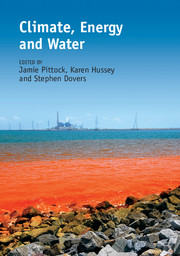Book contents
- Frontmatter
- Contents
- List of contributors
- Acknowledgements
- 1 Justifying, extending and applying “nexus” thinking in the quest for sustainable development
- 2 Water resources, climate change and energy
- 3 Implications of climate change for energy systems in a multisectoral context
- 4 Fossil fuels and water: A complex and evolving relationship
- 5 Renewable energy and water
- 6 Hydropower within the climate, energy and water nexus
- 7 Water and biofuels
- 8 Trade-offs and synergies between water and energy use in rural Australia
- 9 Management of the urban energy-water nexus
- 10 Managing the electricity-water nexus in China, France, India and the United States
- 11 Cross-sectoral governance of the climate, energy and water sectors: A ‘Rubik's cube’ analysis of cross-sectoral co-ordination
- 12 Regulation of the nexus
- 13 Climate, energy and water: the potential roles and limitations of markets
- 14 Strategies to mainstream climate change, energy, water and food security nexus knowledge and skills
- 15 A nexus of nexuses: systemic governance for climate response
- 16 Integrated modelling of the energy-water nexus in the American West
- 17 Biodiversity and the climate, energy and water nexus
- 18 Consumers, food supply chain and the nexus
- 19 Future prospects in climate, energy and water research and policy
- Index
18 - Consumers, food supply chain and the nexus
Published online by Cambridge University Press: 05 April 2015
- Frontmatter
- Contents
- List of contributors
- Acknowledgements
- 1 Justifying, extending and applying “nexus” thinking in the quest for sustainable development
- 2 Water resources, climate change and energy
- 3 Implications of climate change for energy systems in a multisectoral context
- 4 Fossil fuels and water: A complex and evolving relationship
- 5 Renewable energy and water
- 6 Hydropower within the climate, energy and water nexus
- 7 Water and biofuels
- 8 Trade-offs and synergies between water and energy use in rural Australia
- 9 Management of the urban energy-water nexus
- 10 Managing the electricity-water nexus in China, France, India and the United States
- 11 Cross-sectoral governance of the climate, energy and water sectors: A ‘Rubik's cube’ analysis of cross-sectoral co-ordination
- 12 Regulation of the nexus
- 13 Climate, energy and water: the potential roles and limitations of markets
- 14 Strategies to mainstream climate change, energy, water and food security nexus knowledge and skills
- 15 A nexus of nexuses: systemic governance for climate response
- 16 Integrated modelling of the energy-water nexus in the American West
- 17 Biodiversity and the climate, energy and water nexus
- 18 Consumers, food supply chain and the nexus
- 19 Future prospects in climate, energy and water research and policy
- Index
Summary
Introduction
This chapter explores the interactions between the main actors in the food supply chain, also referred to as the food system, from producers to consumers. Governance of these interactions has implications for the use of water, land, energy and the environment, as well as for the economy. The purpose of the chapter is to highlight that the inefficiencies in the system can be significantly reduced with multiple wins. Mainstream approaches focus on production and tend to overlook externalities and trade-offs. The sizeable losses, waste and conversion of the food produced are ignored. An expansion of an increasingly wealthy and urban population poses one set of challenges. Reducing a lingering poverty poses another. On the supply side, global warming and the enhanced uncertainty and variability in water availability signal an era with unprecedented predicaments. With a multitude of drivers and an increasing resource scarcity and uncertainty, a food supply chain perspective is warranted. It helps to improve knowledge about system dynamics: how much and what is produced that is beneficially used, by various socioeconomic groups, and how much goes down the drain. Water is most heavily used in connection with production, whereas significant fractions of energy are used for processing, distribution and among consumers. Greenhouse gas (GHG) emissions dominate the first segments of the supply chain. There are significant potential savings and benefits from a reduction of losses and waste of food in terms of water, energy, money and reduced GHG emissions. Effective policy for environmental health and food security needs to include incentives and demonstrations directed towards consumers apart from policies aiming at producers.
‘Le problème avec notre époque est que le futur n'est plus ce qu' il était’
Paul Valéry (1871–1945)Purpose and contents of chapter
It is recognised that “there is no such a thing as a post-agricultural society” (Weiskel 1988; quoted in many publications, eg Postel 1999).
- Type
- Chapter
- Information
- Climate, Energy and Water , pp. 303 - 323Publisher: Cambridge University PressPrint publication year: 2015
- 1
- Cited by



